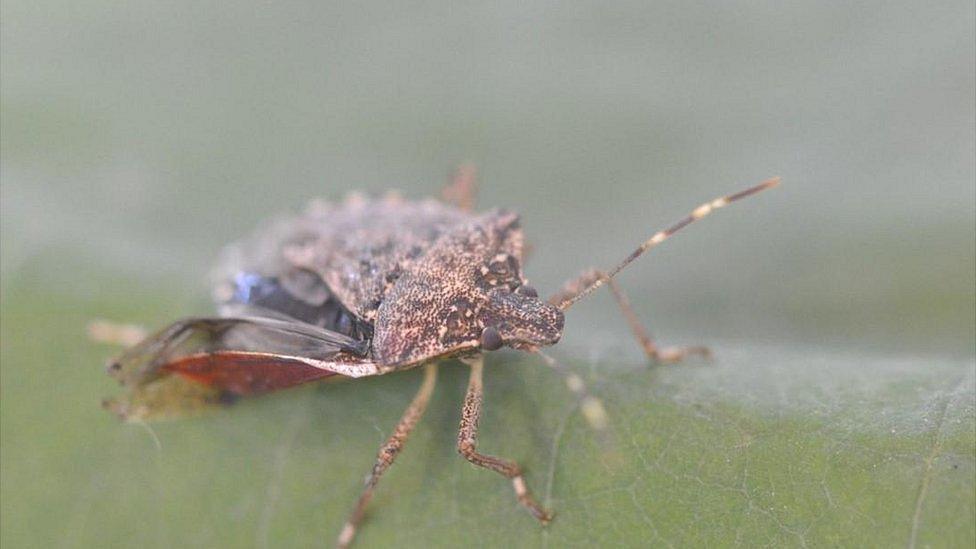Stink bug discovery raises fears of threat to crops
- Published

The bug produces a distinctive smell when disturbed
A stink bug that can spoil crops and infest homes has been trapped in Surrey as part of a monitoring study.
The brown marmorated stink bug is native to Asia, but has spread to parts of Europe and the US, where it can destroy fruit crops.
A lone stink bug was caught at RHS Garden Wisley this summer within weeks of the setting up of a pheromone trap.
The adult may be a stowaway brought in on imported goods or part of an undiscovered local population.
Dr Glen Powell, head of plant health at RHS Garden Wisley, said the stink bug may become commonplace in gardens and in homes within a decade.
"This isn't a sudden invasion but potentially a gradual population build-up and spread, exacerbated by our warming world," he said.

Dr Glen Powell inspects the trap hung in a tree
It's not yet clear if stink bugs are living undetected in parts of England or are rare visitors that hitch-hike in on imported goods or passenger luggage and survive for only a short time. So far, no eggs or immature bugs have been found that would suggest the bug is breeding and has set up home.
The bug has been caught only twice before in pheromone traps set up to lure it in by means of a natural chemical - in all cases as lone instances. The previous finds were at Rainham Marshes in Essex and in the wildlife garden of London's Natural History Museum.
According to the department for the environment, Defra, the bug has been intercepted in the UK on several occasions - in passenger luggage flown in from the US, clothing and wood imports from the US, and stone imported from China.
The trap at Wisley is part of a national monitoring project led by a plant science research company, NIAB EMR, in Kent, and funded by Defra.
Dr Michelle Fountain, head of pest and pathogen ecology at NIAB EMR, said: "[The] brown marmorated stink bug represents a significant threat to food production systems in the UK so it is crucial that we continue to monitor any establishment and spread of the pest."

A single male stink bug was trapped at Wisley in Surrey this summer
There are more than 40 species of stink bugs, also known as shield bugs, already present in the UK. Most pose no threat to plant health and are not considered pests.
Brown marmorated stink bugs, which have a distinctive rectangular-shaped head, get their name from the odour they emit when threatened.
In the US, they can invade houses, clustering in their hundreds, and can be devastating for farmers, destroying fruit such as nectarines and peaches and feeding on a wide range of ornamental trees, vegetables and other plants.
Invasive species cost the UK economy over £1.8bn a year and can threaten the survival of other plants and animals. A Defra spokesperson said: "The brown marmorated stink bug is not a significant threat to our crops - but as with all pests and diseases we will continue to monitor any threats closely."
Anyone finding what they believe to be a brown marmorated stink bug is asked to take a picture and report the sighting at BMSB@niab.com or via email to Entomology@rhs.org.uk.
The insect can be confused with other species - more information can be found here., external
Follow Helen on Twitter., external

WORLD LEADERS EXPOSED: One of the biggest offshore leaks in history
THE NEW LABOUR REVOLUTION: Two powerful personalities at the heart of a political phenomenon
